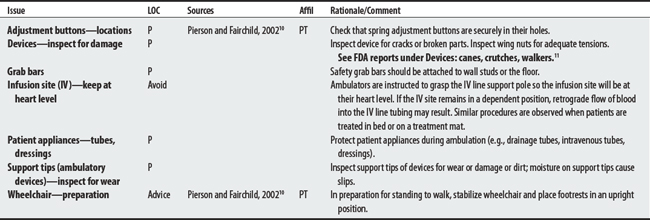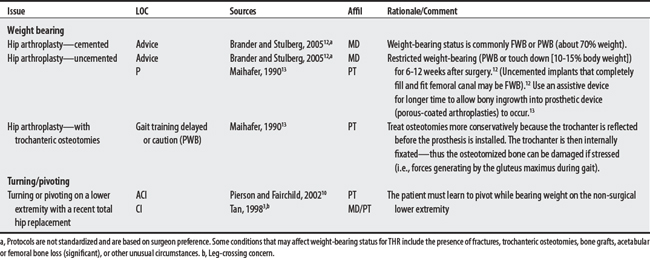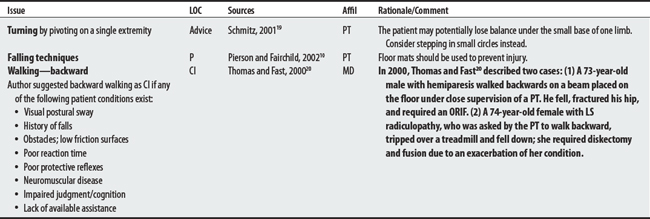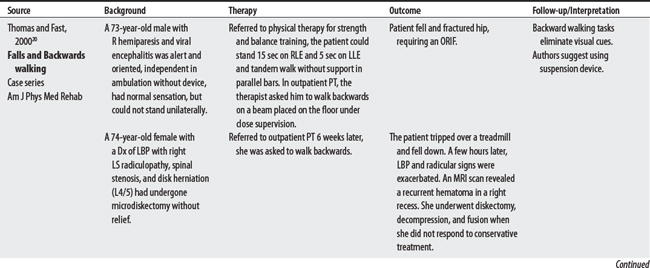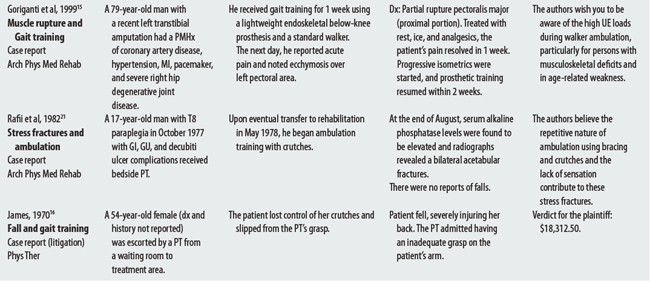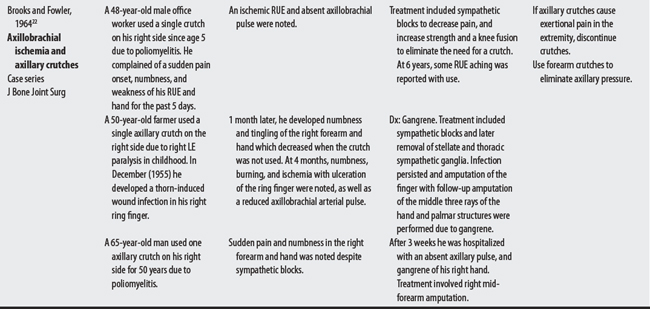Chapter 14 Gait and Locomotion Training
OVERVIEW.
Gait training is a technique of teaching walking skills. Deficient patterns are corrected by attending to muscle imbalances and the biomechanical components of walking during the stance and swing phase.1 Preambulatory skills are often practiced in preparation for walking (mat activities that progress to a standing position). In this section, ambulation/gait training concerns are listed, followed by preambulatory issues.
SUMMARY: CONTRAINDICATIONS AND PRECAUTIONS.
Sources contribute varied concerns for gait training. Major themes for gait training seem to center around (1) patient diagnoses—such as those with activity restriction, (2) environmental hazards, (3) inappropriate patient attire, and (4) hazardous tasks (also see Chapter 29, Assistive Devices, for proper use of equipment).
GAIT TRAINING
CONTRAINDICATIONS AND PRECAUTIONS
PROCEDURAL CONCERNS: TASKS
1 Bottomley JM. Quick reference dictionary for physical therapy. Thorofare (NJ): Slack, 2000.
2 Agnelli G, Hull RD, Hyers TM, et al. Antithrombotic therapy for venous thromboembolic disease: the Seventh ACCP Conference on Antithrombotic and thrombolytic therapy. Chest. 2004;126(3, Suppl):401S-428S.
3 Tan JC. Practical manual of physical medicine and rehabilitation: diagnostics, therapeutics, and basic problems. St Louis: Mosby, 1998.
4 Kisner C, Colby LA. Therapeutic exercise: foundations and techniques, ed 3. Philadelphia: FA Davis, 1996.
5 Bleakney DA, Donahoe M. Osteogenesis imperfecta. In: Campbell SK, Palisono R, Vander Linden, editors. Physical therapy for children. Philadelphia: W.B. Saunders, 1994.
6 Helm PA, Kevorkian CG, Lushbaugh M, et al. Burn injury: rehabilitation management in 1982. Arch Phys Med Rehab. 1982;63:6-16.
7 Spires MC. Rehabilitation of patients with burns. In Braddom RL, editor: Physical medicine and rehabilitation, ed 2, Philadelphia: W.B. Saunders, 2000.
8 Staley M, Serghiou M. Casting guidelines, tips and techniques: proceedings from the 1977 American Burn Association PT/OT Casting Workshop. J Burn Care Rehab. 1998;19(3):254-260.
9 Knight CA. Peripheral vascular disease and wound care. In O’Sullivan SB, Schmitz TJ, editors: Physical rehabilitation and treatment, ed 4, Philadelphia: FA Davis, 2001.
10 Pierson FM, Fairchild SL. Principles and techniques of patient care, ed 3. Philadelphia: W.B. Saunders, 2002.
11 US Food and Drug Administration. Center for Device and Radiological Health. Available at: http://www.fda.gov/cdrh/mdr/.
12 Brander VA, Stulberg SD. Rehabilitation after lower limb joint reconstruction. Delisa JA, editor. Physical medicine and rehabilitation: Principles and practices, vol 1. Philadelphia: Lippincott Williams & Wilkins, 2005.
13 Maihafer GC. Rehabilitation of total hip replacements and fracture management considerations. In: Echternach JL, editor. Physical therapy of the hip. New York: Churchill Livingstone, 1990.
14 Minor MAD, Minor SD. Patient care skills, ed 4. Stamford (CT): Appleton & Lange, 1999.
15 Goriganti MR, Bodack MP, Nagler W. Pectoralis major rupture during gait training: case report. Arch Phys Med Rehab. 1999;80(1):115-117.
16 James CAJr. Medico-legal considerations in the practice of physical therapy. Phys Ther. 1970;50(8):1203-1207.
17 Medical Malpractice Verdict Settlement and Experts, January 1997, p 41, loc 2.
18 Simons DJ. A note on the effect of heat and of cold upon certain symptoms of multiple sclerosis. Bull Neurol Inst N Y. 1937;6:385-386.
19 Schmitz TJ. Preambulatory and gait training. In O’Sullivan SB, Schmitz TJ, editors: Physical rehabilitation and treatment, ed 4, Philadelphia: FA Davis, 2001.
20 Thomas MA, Fast A. One step forward and two steps back: the dangers of walking backwards in therapy. Am J Phys Med Rehab. 2000;79(5):459-461.
21 Rafii M, Firooznia H, Golimbu C, et al. Bilateral acetabular stress fractures in a paraplegic patient. Arch Phys Med Rehab. 1982;63(5):240-241.
22 Brooks AL, Fowler SB. Axillary artery thrombosis after prolonged use of crutches. J Bone Joint Surg. 1964;46A(4):863-864.







